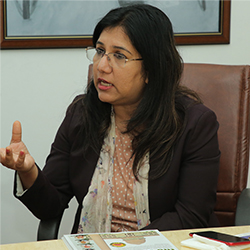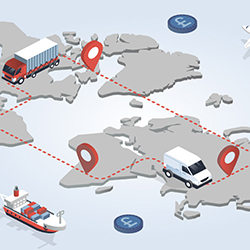Supply Chain Strategist

"As supply chain leader, our objective is to understand what our customer wants and then streamline the supply chain to deliver it efficiently. To achieve this objective right technology, process, and people capability are needed"
- Sharmishtha Niyogi, Supply Chain Director, Merck Group
She is both a working mother and a single parent who has prioritised her child’s development and her corporate journey. Sharmishtha Niyogi, Supply Chain Director, Merck Group, has been an inspiration to many women for over 20 years. From her experience, her advice to aspiring women professionals is to build a strong ecosystem of support around them and aspire to do the best instead of a never-ending race for balance. In an exclusive interview with Corporate Citizen, she talks about her twenty years journey of exploring the supply chain industry, her experiences in the industry and more
Corporate Citizen: Tell us about your career journey, how did you choose supply chain as a career option?

Sharmishtha Niyogi: I was not looking at the supply chain as my career option. Post my graduation in physics from Delhi University, I joined advertising because I wanted to be a big shot marketing advertising person. When I went to the US to pursue a Master of Business Administration (MBA) in marketing, I found supply chain evolving as a strong business function—US universities defining it as a curriculum and specialisation.
Stirred by curiosity, I completed a couple of credits in the supply chain and found it interesting and significant to business profitability. With an internship opportunity within the US retail industry, I said yes to it as an opportunity to see the supply chain in the real business world.
Besides supply chain, I explored various other fields and took credits in IT, Corporate Law, and Computer Science. Completely convinced that supply chain holds my interest, I specialised in supply chain and joined the retail industry in the US. With about 20 years of experience in managing supply chains across several industries, I believe I made the right choice. Supply chain is an integral part of a strategic framework, creating a strong competitive advantage in the industry and impacting the customer experience.
CC: Post-Covid, the sector of the supply chain has started growing and is likely to grow five times more in the coming years, what is that aspect of the supply chain which is leading it towards growth?
Post-Covid, industries across the globe recognised the significance of the supply chain in meeting top-line growth, bottom-line objectives, customer service and sustainability. Through the past couple of years of disruption, emerged industry leaders who could tide through the disruption and gain market share by transforming challenges into a competitive advantage. These were the industry leaders with strong supply chain strategies, progressively investing in supply chain innovation, advanced technology, people and processes over several years.
Supply chain innovation is critical and at the core of building an agile, customer-centric organisation that is risk-averse and future-ready. Innovation and technology in the supply chain usually have a gestation period and take time to implement. It also takes the right people and process. This is the most critical aspect of a strong supply chain for a growing organisation.
AI and Machine Learning (ML) are changing the norms within the supply chain and operations. Currently, the manufacturing industry uses a lot of new and cutting-edge technology that has transformed the traditional methods in the supply chain completely. For instance, Virtual Reality (VR) is used in training people on the shop floor.
We have created VR videos for the workers so that they don't even have to walk through the shop floor, burn their fingers, stumble upon things to learn, or make mistakes. But they can already do that through ML and VR.
AI and ML are revamping operations, presenting a huge opportunity for organisations to add process efficiencies. VR is driving training and troubleshooting, AI is supporting planning and robotics is automating processes.
CC: As you mentioned, machine learning and AI are heavily impacting the entire supply chain industry. How do you incorporate these technologies in the growth of your business?

As supply chain leader, our objective is to understand what our customer wants, and then streamline the supply chain to deliver it efficiently. To achieve this objective right technology, process, and people capability are needed. These essential imperatives are built through the detailed strategic framework of the supply chain. The scale and strategic business objective of the organisation over a horizon play form the foundation in designing the charter, implementation programmes and investment.
AI and ML are being used extensively in supply chains across the industry, from automation of racks in warehouses and robotics in distribution, to network optimisation for lane efficiency to risk mitigation, virtual realityled training of shop floor or operations team, troubleshooting on production lines; automation of analytics and real-time performance dashboards for proactive planning and speed in the decision; AI-based demand planning connecting product designing and vendor development to meet the potential decision.
According to the Gartner Survey of Supply Chain Leaders, AI will have the greatest impact on the supply chain industry through 2025, 16 per cent use automation for better decision-making, 21 per cent improve transportation through automation tools. The adoption of AI and ML is essential to managing the increasing complexity of supply chains.
CC: What are the opportunities to fall in the supply chain in the coming years?
The opportunities are immense —we have just started on this journey. The supply chain of any organisation is vast. The complete gambit within plan-source-make-deliver, starting planning, and spanning across to last-mile supply chain of distribution and supply to end customer, various aspects of the supply chain play a significant role such as procurement, manufacturing, transportation and logistics, trade compliance, quality, research and development, distribution and operations, customer excellence, etc.
Efficiency in all these aspects of the supply chain across the flow of products, information, and payment impacts customers. Therefore, it is essential to have the right capability and regular upskilling of people to adapt to the changing dynamic of the supply chain and manage the ever-evolving technologies and processes in facilitating the complexities of the supply chain, to service the customer.
The opportunities for professionals aspiring to make an impact in the industry are therefore manifold within the supply chain. Starting with people managing daily operations to teams designing advanced technologies to keep the supply chain future-ready.
Another aspect is the reduction of carbon footprinting—the industry has created networks in such a way that it is not polluting the environment. Because supply chain is the highest contributor, starting from how many steps the companies take to get the product from the shelf of the warehouse to how the companies send material from China to Australia to India to Europe. So, now the industry is trying to minimise carbon footprint by maximising the utilisation of technology and that's the best part of the supply chain. The supply chain industry needs very strong freshers who can grab those new technologies, understand the insights and help the business. This is the best time for us as supply chain professionals.
"Work is part of life and not something separate that needs balancing with life. It is a personal choice to prioritise it over other aspects of life from time to time"
CC: You went to the US to study marketing; then how did you switch to the supply chain industry?
Like every other young aspiring professional, I was dazzled by a career in advertising and marketing and joined an advertising agency. With more exposure to business and work experience, I realised the significance of the supply chain in the overall strategy of the organisation and gravitated toward it. I believe I made the right choice. The supply chain is ever-growing and has immense opportunity and scope for talented professionals to contribute and grow.
I started my career in advertising and aspired to pursue an MBA with a specialisation in marketing. Over some time, after joining the MBA programme in the US, I was introduced to various facets of management and my perspective broadened. Through taking courses and internships, my appreciation for supply chain developed over a period and I could perceive its impact on business. Over the past couple of decades, my perception deepened further. The progressive industry leaders have consistently valued this function and invested in strengthening the supply chain and operations to strengthen, in turn, its ability to take customer experience to the next level.
It is important to know that the supply chain offers women professionals and leadership equal opportunities to grow. Most companies are looking to build women leaders in this somewhat male-dominated function. In the past few decades, the myth around supply chains perceived as not suitable for women has been challenged by companies and progressive leaders, hiring women professionals at all levels. Distribution centers, shopfloors, and manufacturing facilities are welcoming women employees and making their way into supply chain function through hands-on experience. Unlike some old perception, this work is not only safe but also provides a wide range of opportunities to start a career, perform and grow.
I learned from my experience that we should gain industry experience before choosing our field of specialisation. Also, we must be open to new ideas, diverse facets of business and opportunities in new business domains, all through our career and professional trajectory.
CC: Is working in the supply chain industry hectic for you, as this job entails constant pressure to meet targets and fulfil orders?
Contrary to the belief, I do not find work hectic. I thrive in stress, and the challenges keep me active and innovative. Every challenge and target is an opportunity for us to use a creative way to simplify and innovate. Most of the time new ways and process improvements emerge out of such a scenario, which brings out excellence and learning that fuels further improvement and efficiency. I believe the real excitement is in accepting a stretch target and exceeding it.
CC: How do you maintain a work-life balance amidst this hectic schedule?
Work-life balance is the biggest myth we have and almost everyone is chasing that impossibility. Work is an aspect of life like everything else, and it is a personal choice to prioritise it over other aspects of life from time to time. There will never be a balance, just doing the best we can at any point in time. After years of struggling to balance, I have now consciously stopped to strive for balance. I do what I like to do. If work challenges me, I take it by the proverbial bull by the horns. If other aspects of life need my focus, I take care of it. Work is part of life and not something separate that needs balancing with life.
"Global dynamics are ever-changing and India is at a point of inflection, where every one of us can have our share of success by being confident and contributing with full commitment "
CC: For working women, especially for a mother, it gets challenging to work unconditionally in an industry like supply chain. Share your thoughts on this.

For working women, there is a need to have a very strong ecosystem. We should have mentors, coaches and support groups to help us successfully navigate through the highs and lows of playing various roles in life and career. With more women participating in the workforce, society is opening up and partnering with women in their success. Most companies are progressive and ready to support diverse employees through flexible work, daycare facilities, sabbaticals, etc.
By no means I am discounting the challenges women face in their professional journey, but then we must stay strong on the journey and resolve the issues. We have that capability. A path less taken is full of challenges. The more we tread on the path, the more there will be opportunities and creative ways to resolve the issue. It will also provide opportunities for more support industries to spring open.
Working women are not only essential for the well-being of women and overall society, it is crucial for the growth of the economy and the country. To keep ourselves and other women professionals steadfast on this journey, we must be her ecosystem, and whenever possible give her a shout-out and empower her.
CC: What are the qualities this young generation needs to have to step into the profession of supply chain?
I advise all the millennials that they need to have perseverance and patience. They are very dynamic, the information flow for them is dynamic as well. That makes their decision- making ability faster than before. This is a good trend and will facilitate growth for the industry. However, the young generation must also have the patience to allow their decisions to evolve and give the required time for the benefits to follow. They must also build trust in their learning curve and see the advantage. While it took Edison 1,000 attempts to invent the bulb, with today’s cutting edge information technology, it may not take as many attempts but innovation will require some trial and error.
My message to the new generation of India is that global dynamics are ever-changing and India is at a point of inflection, where every one of us can have our share of success by being confident and contributing with full commitment. The education system in India is well-proven, robust, and successful in building generations of strong professionals. You are driven, committed, capable and most importantly passionate. It is now time for each of you to recognise these strengths, build leadership and expand possibilities through your contribution.